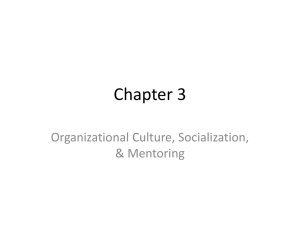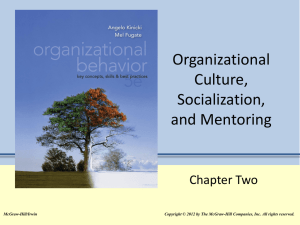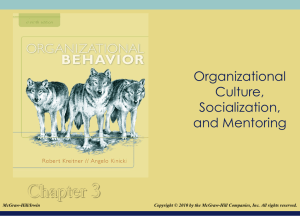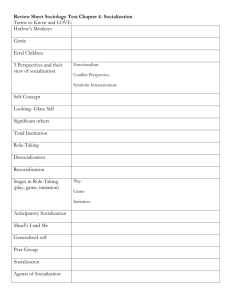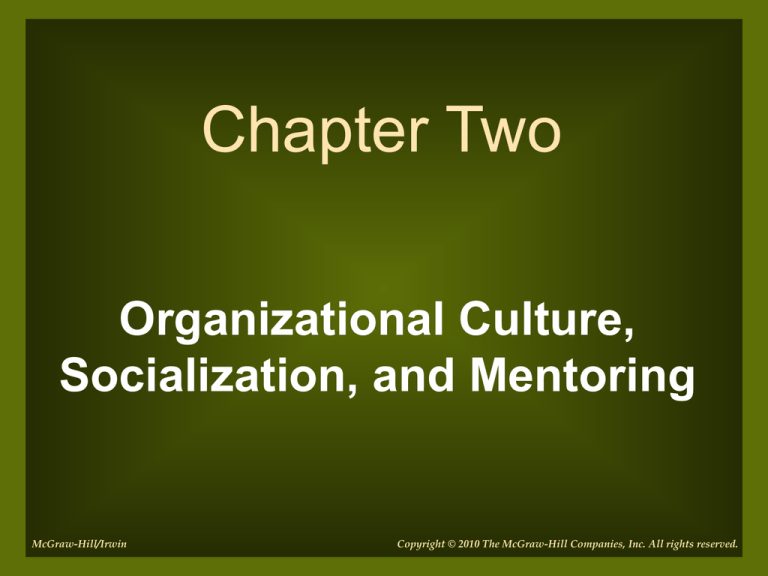
Chapter Two
Organizational Culture,
Socialization, and Mentoring
McGraw-Hill/Irwin
Copyright © 2010 The McGraw-Hill Companies, Inc. All rights reserved.
After reading the materials in this
chapter, you should be able to:
• Discuss the layers and functions of organizational
culture.
• Describe the general types of organizational culture
and their associated characteristics.
• Summarize the process by which organizations change
their cultures.
• Describe the three phases in Feldman’s model of
organizational socialization.
• Discuss the various tactics used to socialize
employees.
• Explain the four types of developmental networks
derived from a developmental network model of
mentoring
2-2
Organizational Culture
• Organizational culture
- set of shared, taken-for-granted implicit
assumptions that a group holds and that
determines how it perceives, thinks about and
reacts to its various environments
2-3
Organizational Culture
Characteristics
• Passed on to new employees through the
process of socialization
• Influences our behavior at work
• Operates at different
levels
2-4
A Conceptual Framework for Understanding
Organizational Culture
Figure 2-1
2-5
Layers of Organizational Culture
• Observable artifacts
- Consist of the physical manifestation of an
organization’s culture
- Acronyms, manner of dress, awards, myths
and stories, published lists of values,
observable rituals and ceremonies, special
parking spaces, and decorations
2-6
Question?
Every month, Bombay Bazaar awards an
"Employee of the Month" award to one employee
and as a reward offers a $100 check and an
assigned parking space with the employees'
name for the month. This is an example of which
of these?
A. Basic underlying assumption
B. Externally enacted values
C. Observable artifacts
D. Socialization
2-7
Layers of Organizational Culture
• Enacted values
- represent the values and norms that actually
are exhibited or converted into employee
behavior
- Based on
observable behavior
2-8
Layers of Organizational Culture
• Basic assumptions
- Constitute organizational values that have
become so taken for granted over time that
they become assumptions that guide
organizational behavior
2-9
Four Functions of Organizational Culture
Figure 2-2
2-10
Competing Values Framework
Figure 2.3
2-11
Question?
Fredhandbag Photography is a familyowned business. All of the employees are
encouraged to speak up with any ideas to
improve the business. What type of culture
does this resemble?
A.
B.
C.
D.
Clan
Adhocracy
Hierarchy
Market
2-12
Outcomes Associated with
Organizational Culture
1. Significantly correlated with employee
behavior and attitudes
2. Congruence between an individual’s
values and the organization’s values was
associated with organizational
commitment, job satisfaction, intention to
quit, and turnover
2-13
Outcomes Associated with
Organizational Culture (cont.)
3. There is not a clear pattern of
relationships between organizational
culture and outcomes such as service
quality, customer satisfaction, and an
organization’s financial performance
4. Mergers frequently failed due to
incompatible cultures
2-14
The Process of Culture Change
• Organizational
members teach
each other about
the organization’s
preferred values,
beliefs,
expectations, and
behaviors
2-15
The Process of Culture Change
1. Formal statements of organizational philosophy,
mission, vision, values, and materials used for
recruiting, selection and socialization
2. The design of physical space, work
environments, and buildings
3. Slogans, language, acronyms, and sayings
4. Deliberate role modeling, training programs,
teaching and coaching by managers and
supervisors
5. Explicit rewards, status symbols (e.g., titles),
and promotion criteria
2-16
The Process of Culture Change
6. Stories, legends, and myths about key people and
events
7. The organizational activities, processes, or outcomes
that leaders pay attention to, measure, and control
8. Leader reactions to critical incidents and
organizational crises
9. The workflow and organizational structure
10. Organizational systems and procedures
11. Organizational goals and the associated criteria used
for recruitment, selection, development, promotion,
layoffs, and retirement of people
2-17
Organizational Socialization
• Organizational Socialization
- process by which a person learns the values,
norms, and required behaviors which permit
him to participate as a member of the
organization
2-18
A Model of Organizational
Socialization
Figure 2-4
2-19
Phase 1: Anticipatory Socialization
• Occurs before an individual joins an
organization
• Involves the information people learn about
different careers, occupations, professions,
and organizations
2-20
Phase 2: Encounter
• Employees learn what the organization is
really like and reconcile unmet
expectations
• Onboarding – programs aimed at helping
employees integrate, assimilate, and
transition to new jobs
2-21
Question?
Amy recently started a new job. Everyone she interviewed
with seemed very personable and easy-going. She was
quite surprised when during her first week on the job she
witnessed a loud and argumentative confrontation in the
hallway between two of her coworkers. People seem so
different than the way she expected them to be. Amy is in
which stage of the socialization process?
A. Change and acquisition
B. Anticipatory socialization
C. Adaptive
D. Encounter
2-22
Phase 3: Change and Acquisition
• Requires employees
to master important
tasks and roles and to
adjust to their work
group’s values and
norms
2-23
Practical Application of
Socialization Research
1. Managers should avoid a haphazard
approach to organizational socialization
2. Managers play a key role during the
encounter phase
3. Organization can benefit by training new
employees to use proactive socialization
behaviors
4. Managers should pay attention to the
socialization of diverse employees
2-24
Socialization Tactics
2-25
Question?
Army recruits must attend boot camp before
they can work alongside established
soldiers. This is an example of _________
socialization.
A. Collective
B. Individual
C. Formal
D. Disjunctive
2-26
Embedding Organizational Culture
through Mentoring
• Mentoring
- the process of forming and maintaining
developmental relationships between a
mentor and
a junior person
2-27
Developmental Networks Underlying
Mentoring
• Diversity of developmental relationships
- reflects the variety of people in a network used
for developmental assistance
2-28
Developmental Networks Associated
with Mentoring
2-29
Figure 2-5
Question?
Troy received a job offer straight out of college and moved
to Omaha, Nebraska a year ago. He has been introduced
to numerous people in his workplace, his community, and
his church. Although it's nice to see a familiar face, he
doesn't see them too often and feels like he doesn't know
them very well. Which type of developmental network
best describes Troy's situation?
A. Counseling
B. Receptive
C. Traditional
D. Opportunistic
2-30
Mentoring
• Developmental relationship strength
reflects the quality of relationships among
the individual and those involved in his
developmental
network
2-31
Personal and Organizational
Implications
• Job and career satisfaction are likely to be
influenced by the consistency between an
individual’s career goals and the type of
developmental network at his disposal
2-32
Personal and Organizational
Implications
• A developer’s willingness to provide career
and psycho-social assistance is a function
of the protégé’s ability, potential, and the
quality of the interpersonal relationship
2-33
Building an
Effective Mentoring Network
1. Become the perfect protégé
2. Engage in 360-degree networking
3. Commit to assessing, building, and
adjusting the mentor network
4. Develop diverse, synergistic connections
5. Realize that change is inevitable and that
all good things come to an end
2-34
Supplemental Slides
• Slides 38-44 contain extra non-text
examples to integrate and enhance
instructor lectures
-
Slide 38: Mentoring
Slides 39: Management in the Movies: Hoosiers
Slide 40: Starbucks Canada
Slide 41: Mentoring Pitfalls
Slide 42: Implications For Mentoring Minorities
Slide 43-44: Video discussion slides
2-35
Mentoring
• See Belle Rose
Ragins’s article
abstract on barriers
to mentoring at
Human Relations
Online
2-36
Management in the Movies
Hoosiers – “Warm Welcome”
• In this scene, Coach Dale has been invited to
meet and greet with some of the men of the town.
• Discussion Questions
• What are some of the aspects of the town
culture?
• How well does Coach Dale accept this
organizational socialization?
• How do the men communicate the culture to
Coach Dale?
2-37
Example: Starbucks Canada
• Measures status of corporate culture
using “The Partner View Survey” every 18
months
• 90% response rate
• Corrective action or changes taken
• Result: lower turnover, higher satisfaction
2-38
Mentoring Pitfalls
• 50% of 500 biggest businesses in US
offer mentoring
• Relationships can sour if:
1.
2.
3.
4.
Pair is incompatible
There is a lack of respect/credibility
Clear goals are not established
There is no consensus on when to end
the relationship
Source: BusinessWeek, January 29, 2007, Mentoring Can Be Messy, Susan Berfield
2-39
Implications For Mentoring Minorities
• Mentors must fully appreciate the roles they
play:
- Coach
- Advocate
- Counselor
• Understand the importance of these roles at
each stage of a protégé’s career
• Mentor must also be aware of challenges race
can present to protégé’s career
2-40
Video Case: Johnson & Johnson
Credo
• What makes Johnson & Johnson’s credo stand
out from those espoused by other companies?
• How does the credo guide the actions of the
employees at Johnson & Johnson?
• Why would the basic premises of the credo be
able to remain so constant after nearly 70 years?
• What are the basic values expressed by the
credo? Why are they important to Johnson &
Johnson’s success?
2-41
Video Case: New Belgium Brewery
• What is different about New Belgium Brewery’s
culture?
• Employees at New Belgium Brewery appear to be
highly engaged in their jobs. Why is this?
• How does the culture at New Belgium Brewery
contribute to their level of financial success?
• Is open books management a management
system all organizations should consider? Why
or why not?
2-42


